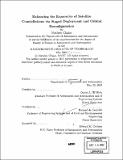Enhancing the economics of satellite constellations via staged deployment and orbital reconfiguration
Author(s)
Chaize, Mathieu, 1980-
DownloadFull printable version (13.01Mb)
Other Contributors
Massachusetts Institute of Technology. Dept. of Aeronautics and Astronautics.
Advisor
Olivier L. de Weck and Richard de Neufville.
Terms of use
Metadata
Show full item recordAbstract
The "traditional" way of designing constellations of communications satellites is to optimize the design for a specific global capacity. This approach is based on a forecast of the expected number of users and their activity level, both of which are highly uncertain. It can lead to economic failure if the actual demand is smaller than the one predicted. This thesis presents an alternative approach to the design process to reduce the economic risks. It proposes to deploy constellations in a staged manner, starting with a smaller, more affordable capacity that can be increased if necessary. When the capacity is increased, additional satellites have to be launched and the existing constellation needs to be reconfigured on orbit. Technically, it implies that particular design elements are initially embedded in the design to allow the reconfiguration. Such elements are called "real options" and give decision makers the right but not the obligation to increase the capacity of the system after its initial deployment. This approach reframes the design objectives. Instead of determining an optimal design for a specific capacity, paths of architectures are sought in the trade space. A general framework is presented to identify the paths that offer the most flexibility given different demand scenarios. It is then applied to LEO constellations of communications satellites. Improvements in the life cycle costs on the order of 30% can be obtained for different discount rates and volatilities. This value of flexibility has to be compared to the actual price of the real options. A general method is proposed to study this problem and two technical solutions are proposed.
Description
Thesis (S.M.)--Massachusetts Institute of Technology, Dept. of Aeronautics and Astronautics, 2003. Includes bibliographical references (p. 171-175).
Date issued
2003Department
Massachusetts Institute of Technology. Department of Aeronautics and AstronauticsPublisher
Massachusetts Institute of Technology
Keywords
Aeronautics and Astronautics.